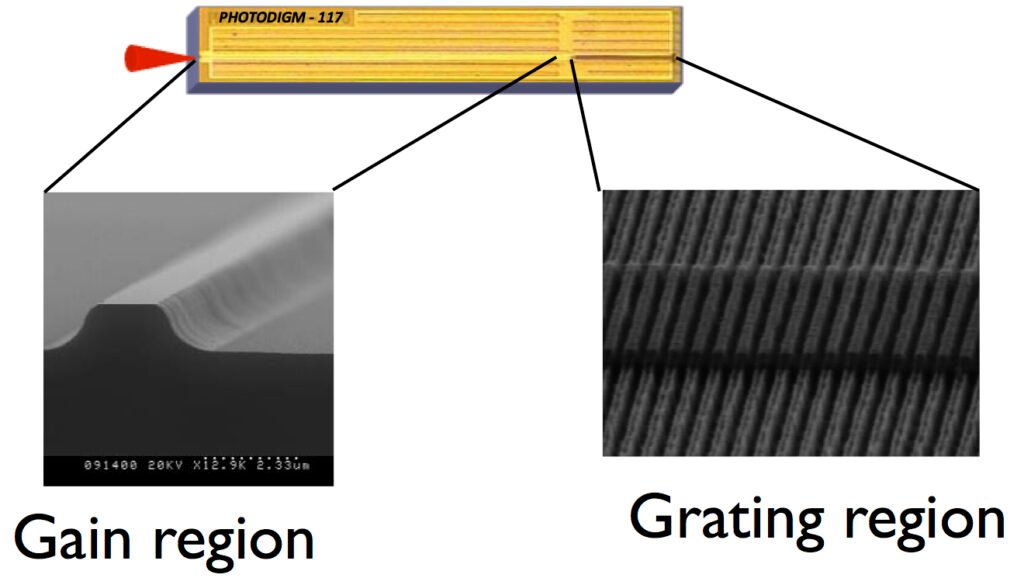Distributed Bragg Reflector (DBR) lasers represent a fascinating facet of laser technology, distinguished by their unique resonator design incorporating at least one DBR outside the active region, setting them apart from traditional lasers. This resonator design integrates a Bragg mirror, a reflective device founded on Bragg reflection at a periodic structure, typically functioning as a quarter-wave mirror for maximum reflection.
Contents
DBR Laser Diodes: Masters of Precision and Tunability
Structure and Operation: DBR laser diodes are the stalwarts of precision and tunability in the laser realm. These diodes feature a corrugated waveguide structure (grating section) that provides wavelength-dependent feedback, defining the emission wavelength. The active region serves as the amplifying medium, and the laser waveguide’s other end often features another DBR.
Features:
- Single-Frequency Operation: DBR laser diodes are primarily single-frequency lasers, boasting diffraction-limited output.
- Wavelength Tunability: Many DBR laser diodes are wavelength-tunable, achieved within the free spectral range of the laser resonator. Tuning methods include electrical heating or temperature variation.
- Sophisticated Designs: Advanced designs, such as SG-DBR lasers, exploit Vernier effects with sampled gratings, offering wide tuning ranges with minimized mode hops.
- Output Characteristics: The linewidth of DBR diodes typically ranges in the megahertz, slightly larger than external-cavity diode lasers due to the shorter laser resonator.
Applications:
- Optical fiber communications
- Free-space optical communications
- Laser cooling
- Optical metrology and sensors
- High-resolution laser spectroscopy
Variants and Enhancements:
- MOPA Structures: Some configurations feature additional amplifier sections on the same chip, achieving output powers well above 100 mW.
- Broad-Area Laser Diodes: High powers (> 10 W) are attainable using broad-area laser diodes with surface Bragg gratings, albeit with a broader emission bandwidth.
Vertical Cavity Surface-Emitting Lasers (VCSELs): Interestingly, VCSELs fall under the category of DBR lasers, even though the term “DBR laser diodes” is conventionally reserved for edge-emitting semiconductor lasers.
Competition and Compact Solutions: DBR laser diodes often compete with external-cavity diode lasers (ECDLs), providing wavelength-tunable single-frequency output but with potentially better noise performance. DBR laser arrays on chips offer compact sources for wavelength division multiplexing systems.
DBR Fiber Lasers: Unleashing Precision with Fibers
Construction: DBR fiber lasers take advantage of a linear laser resonator formed by an active (rare-earth-doped) fiber sandwiched between two fiber Bragg gratings. Compared to fiber Distributed Feedback (DFB) lasers, DBR fiber lasers have longer resonators, offering potential benefits in output power, power efficiency, and linewidth.
Characteristics:
- Output Power: Single-frequency DBR fiber lasers achieve output powers similar to DBR laser diodes, ranging from tens of milliwatts to occasionally over 100 mW.
- Sampled Grating Designs: Similar to their diode counterparts, DBR fiber lasers can incorporate sampled grating designs for wider tuning ranges.
Applications:
- High-precision optical metrology
- Sensing applications
- Fiber testing
- Analytics
- Raman spectroscopy
- Frequency conversion
Leading Suppliers in the DBR Laser Realm:
Several prominent suppliers cater to the diverse needs of DBR lasers, offering cutting-edge solutions for a range of applications:
- Vescent Photonics: Known for D2-200 DBR-based tunable single-frequency diode lasers for precision spectroscopy.
- eagleyard Photonics: Offers DBR lasers with built-in resistors, ensuring mode-hop-free tunability for sophisticated industry applications.
- Sacher Lasertechnik: Provides DBR lasers with emission wavelengths spanning from 760 nm to 1083 nm, available in free-space and fiber-coupled versions.
- TOPTICA Photonics: Features distributed feedback (DFB) laser diodes with grating structures for longitudinal and transverse single-mode operation, with applications in alkaline spectroscopy, laser cooling, gas detection, and tunable continuous-wave terahertz radiation generation.
In essence, Distributed Bragg Reflector lasers, whether in diode or fiber form, stand at the forefront of precision, tunability, and diverse applications in the ever-evolving landscape of laser technology. Their ability to seamlessly integrate into various systems, offering tailored solutions for specific needs, solidifies their place as indispensable tools in the optical toolkit of researchers and industry professionals alike.



